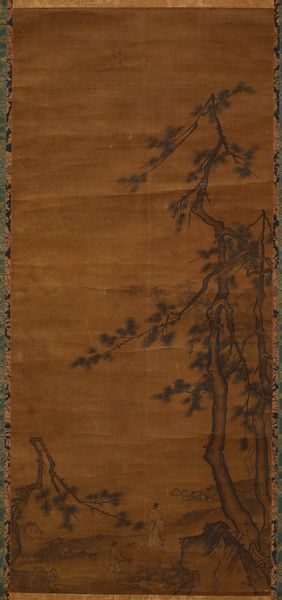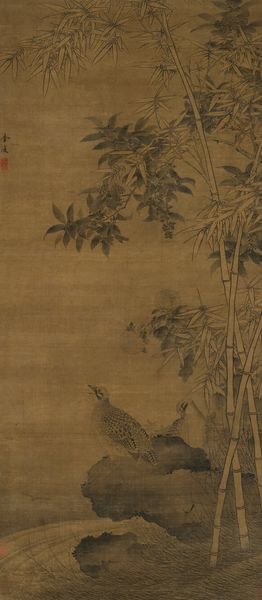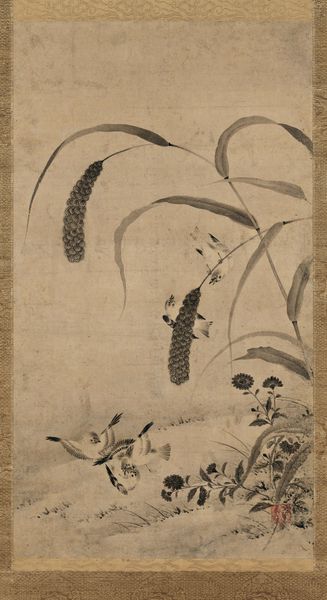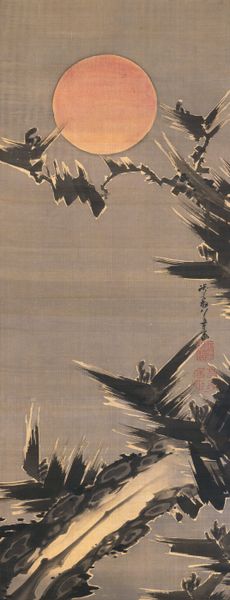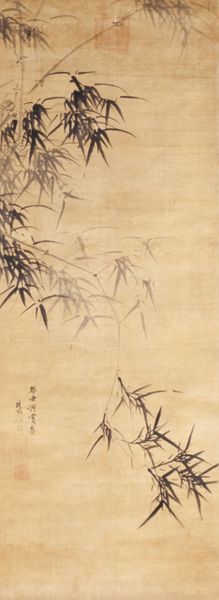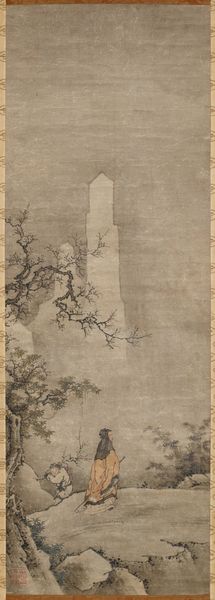
Sparrow on Bamboo in the Rain c. 15th century
0:00
0:00
drawing, painting, paper, ink-on-paper, hanging-scroll, ink
#
drawing
#
aged paper
#
toned paper
#
painting
#
asian-art
#
landscape
#
figuration
#
paper
#
ink-on-paper
#
hanging-scroll
#
ink
#
orientalism
#
line
Dimensions: 28 3/16 × 12 in. (71.6 × 30.48 cm) (image)70 7/8 × 17 in. (180.02 × 43.18 cm) (mount, without roller)
Copyright: Public Domain
Curator: Here we have "Sparrow on Bamboo in the Rain," a hanging scroll in ink on paper, likely dating from the 15th century. It is now part of the collection here at the Minneapolis Institute of Art, and is traditionally attributed to the artist Muqi Fachang. What's your first take on this one? Editor: My immediate feeling is...melancholy. That little sparrow looks quite exposed. And the washes of ink give a real sense of a damp, chilly day. It also looks deceptively simple at first glance. Curator: Indeed. There's a real sense of Zen emptiness. I almost feel like the aged paper IS the painting, the drawing merely accents this aged canvas, bringing forth nature. I also notice the beautiful floral details along the edges. That looks to be brocade of some kind? Editor: Yes, and consider the paper itself, its production, and likely preciousness at the time. The level of skill required to paint with such intentionality and precision using those raw materials is really incredible. There's a great emphasis on labor there, wouldn’t you say? It speaks to me of trade, skill, preciousness. Not the preciousness of subject matter, but of material. Curator: And there's also that very East Asian artistic convention that an artist is creating an ideal; representing perfection rather than photographic reality. It feels as though it has been captured during a stolen, private moment. As though we've seen something intimate. That is something the artist's touch, their labor has done. Editor: Perhaps it is not so simple as mere labor, either. What's often missed is the socio-political contexts in which works such as this are made. I mean, were we to dig into it, I wonder about the status of the painter, who was commissioning, consuming these sorts of works? To fully analyze its creation, you really can't remove it from systems of power. What were the workshops like where artists were trained in these precise painting techniques? Curator: Ah, yes, absolutely essential questions. Though for me, in a gallery space, in a quiet moment... all that fades into this singular image, this delicate little sparrow in the rain. It reminds me to stay open to both the pain and beauty around me. Editor: And for me, it makes me contemplate the supply chains that lead to that brush touching the paper. Interesting how one little bird can make us go on completely separate tangents!
Comments
minneapolisinstituteofart almost 2 years ago
⋮
This simple painting of a single sparrow resting on a shoot of bamboo in the rain was treasured in Japan for more than five hundred years. Over time, it accumulated numerous storage boxes, wrappings, and documents. In this gallery, you can explore the painting and its history through these accumulated objects. In medieval Japan, the Zen monk-painter Muqi Fachang (c. 1210–after 1269) was the most beloved of all Chinese artists. Japanese Zen monks visiting China met or heard of Muqi, acquired his paintings, and brought them back home to Japan. Within a few decades, the foremost Japanese art collections all contained paintings purported to be by Muqi, although many of them were probably not by Muqi himself. But this did not seem to matter. In Japan, “Muqi pictures”—some by Muqi, others in his style—were in high demand as luxury items, and numerous Japanese painters mastered Muqi-style painting and Muqi-specific subject matter. “Muqi pictures” like this one were also sought after for display during tea ceremonies. One of the most famous of these “Muqi pictures” showed sparrows huddled together on a bamboo shoot during rain. That painting made its way into medieval Japan’s most famous collection of Chinese art—that of the Ashikaga shoguns (Japan’s military leaders). It undoubtedly inspired this image of a sparrow on bamboo. Although it was not painted by Muqi himself, it was treasured for generations as a “Muqi picture,” as evidenced by its many boxes, wrappers, and documents, all displayed here.
Join the conversation
Join millions of artists and users on Artera today and experience the ultimate creative platform.

